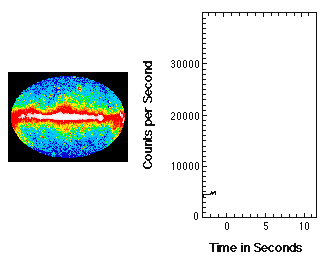
|
Explanation: Using graphics and data from NASA's Compton Gamma Ray Observatory, this animation illustrates one of the most exciting mysteries of modern astrophysics, gamma-ray bursts. Incredibly gamma-ray bursts, sudden flashes of radiation with over 100,000 times the energy of visible light photons, occur several times a day. They typically last from fractions of a second to many minutes and appear from random directions, unexpectedly triggering space-based gamma-ray instruments. At left a burst suddenly appears, flickers and fades in a false-color gamma-ray all-sky map, briefly overwhelming all other sources of celestial gamma-rays. The graph at right shows the corresponding response of an orbiting gamma-ray detector as its counting rate suddenly climbs and falls recording the passage of the mysterious burst. Originating far across the Universe, gamma-ray bursts are now known to be the most powerful explosions since the big bang and may yet prove to be useful tools for exploring the distant cosmos. Future space and ground-based observatories will also work to discover the nature of the bursters and the source of their extreme energy.
|
January February March April May June July August September October November December |
| ||||||||||||||||||||||||||||||||||||||||||||||||
NASA Web Site Statements, Warnings, and Disclaimers
NASA Official: Jay Norris. Specific rights apply.
A service of: LHEA at NASA / GSFC
& Michigan Tech. U.
Based on Astronomy Picture
Of the Day
Publications with keywords: gamma-ray burst - gamma ray
Publications with words: gamma-ray burst - gamma ray
See also:
- Supernova Remnant CTA 1
- APOD: 2024 August 21 Á Fermis 12 year All Sky Gamma ray Map
- APOD: 2023 September 6 Á HESS Telescopes Explore the High Energy Sky
- HESS Telescopes Explore the High Energy Sky
- Cherenkov Telescope at Sunset
- Fermi Science Playoffs
- GW170817: A Spectacular Multiradiation Merger Event Detected
